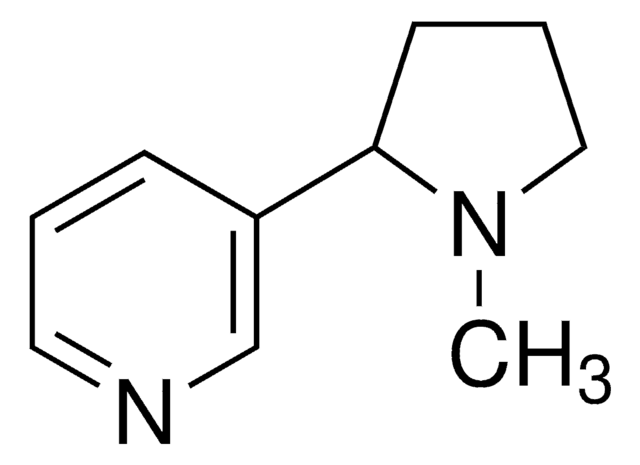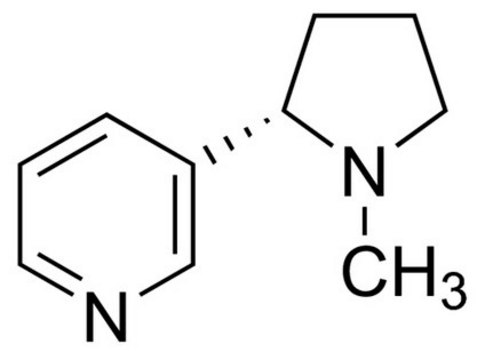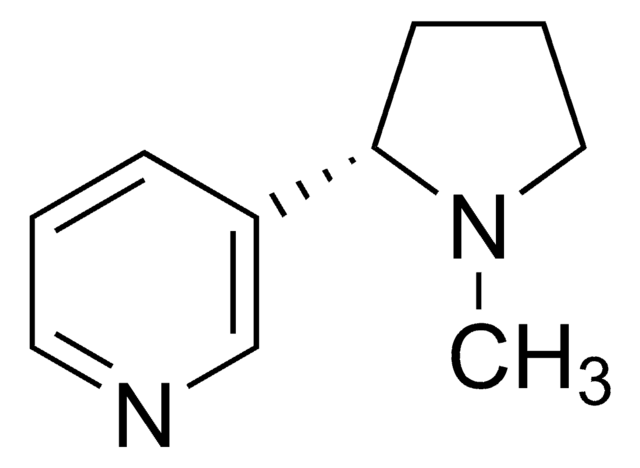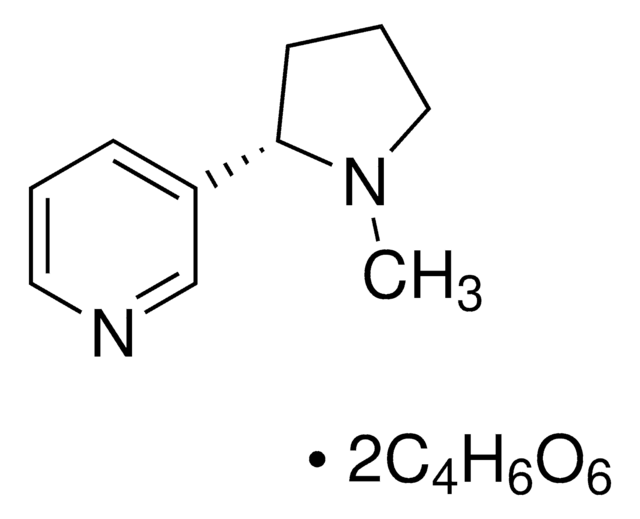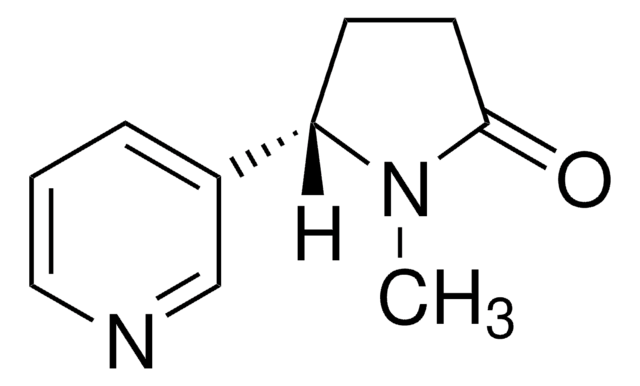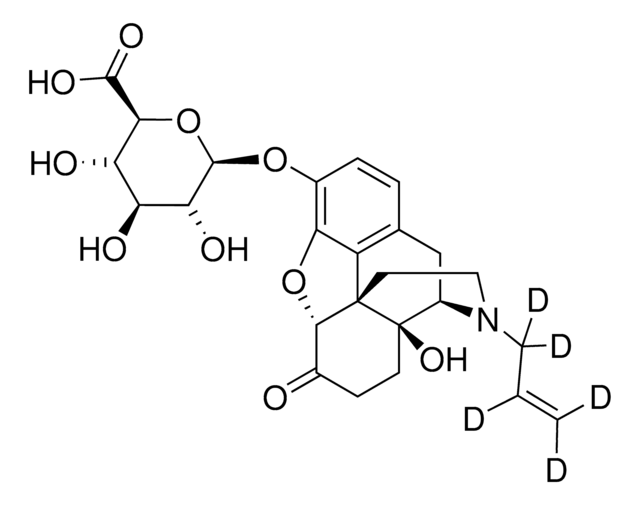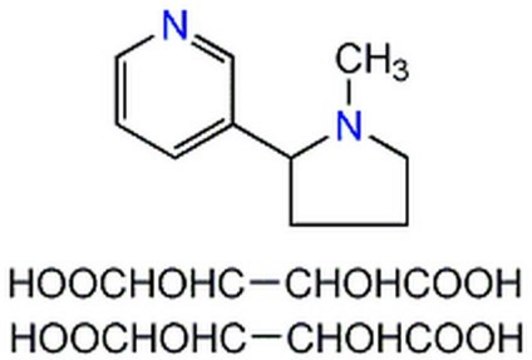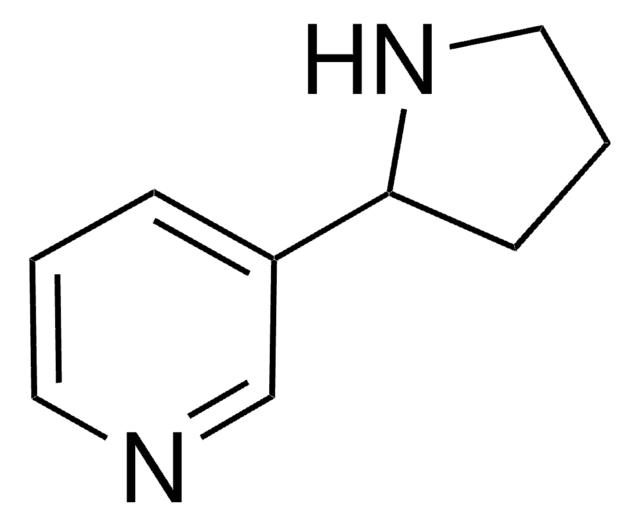N3876
(−)-Nicotine
≥99% (GC), liquid
Synonym(s):
(−)-1-Methyl-2-(3-pyridyl)pyrrolidine, (S)-3-(1-Methyl-2-pyrrolidinyl)pyridine
About This Item
Recommended Products
Quality Level
Assay
≥99% (GC)
form
liquid
optical activity
[α]20/D −169°(lit.)
color
yellow
refractive index
n20/D 1.5265 (lit.)
solubility
ethanol: 50 mg/mL
density
1.010 g/mL at 20 °C (lit.)
SMILES string
CN1CCC[C@H]1c2cccnc2
InChI
1S/C10H14N2/c1-12-7-3-5-10(12)9-4-2-6-11-8-9/h2,4,6,8,10H,3,5,7H2,1H3/t10-/m0/s1
InChI key
SNICXCGAKADSCV-JTQLQIEISA-N
Gene Information
human ... CHRNA2(1135) , CHRNA3(1136) , CHRNA4(1137) , CHRNB2(1141) , CHRNB4(1143) , CYP2A6(1548) , KCNH1(3756)
mouse ... Chrna7(11441) , Chrnb1(11443)
rat ... Chrna1(79557) , Chrna2(170945) , Chrna4(25590) , Chrna7(25302) , Chrnb2(54239) , Chrnb4(25103)
Looking for similar products? Visit Product Comparison Guide
General description
Application
- to stimulate neutrophils in extracellular DNA fluorescence assay and in immunostaining of neutrophils
- to study the effects of chronic neonatal nicotine exposure on nicotinic acetylcholine receptor (nAChR) binding, cell death and morphology in hippocampus and cerebellum
- in an in vitro study to evaluate the effect of root exposure to nicotine or cotinine on the morphology and density of fibroblasts
Biochem/physiol Actions
Preparation Note
Signal Word
Danger
Hazard Statements
Precautionary Statements
Hazard Classifications
Acute Tox. 1 Oral - Acute Tox. 2 Dermal - Acute Tox. 2 Inhalation - Aquatic Chronic 2 - Eye Dam. 1 - Skin Irrit. 2
Storage Class Code
6.1A - Combustible acute toxic Cat. 1 and 2 / very toxic hazardous materials
WGK
WGK 3
Flash Point(F)
213.8 °F - closed cup
Flash Point(C)
101 °C - closed cup
Personal Protective Equipment
Regulatory Information
Choose from one of the most recent versions:
Already Own This Product?
Find documentation for the products that you have recently purchased in the Document Library.
Which document(s) contains shelf-life or expiration date information for a given product?
If available for a given product, the recommended re-test date or the expiration date can be found on the Certificate of Analysis.
How do I get lot-specific information or a Certificate of Analysis?
The lot specific COA document can be found by entering the lot number above under the "Documents" section.
What is the concentration of Product N3876, (-)-Nicotine?
This product is not a solution. It is a liquid. The physical state of (-)-Nicotine is a liquid at room temperature. It has not been dissolved in any solvent at a specific concentration to prepare a solution. The density of (-)-Nicotine as a liquid at 20 °C is 1.010 g/mL.
What is the molarity of Product N3876, (-)-Nicotine?
The molarity of (-)-Nicotine is 6.23 M based on a 100% pure compound with a density at 20 °C equal to 1.010 g/mL. If you multiply this density by 1000, you obtain g/L. If you divide g/L by the molecular weight of (-)-Nicotine which is 162.2 g/mole, you get moles per L which is molarity. [1.010 x 1000]/162.2 = 6.23 M.
Where should Product N3876, (-)-Nicotine, be stored and what sensitivities does it have?
For long-term storage, this product can be stored at room temperature. This compound is very hygroscopic and can darken in color on exposure to air and light.
What is the difference between Nicotine, Products N3876 and N0267?
Prod. No. N3876 is the naturally occurring (-) isomer while Prod. No. N0267 is a mixture of the (+) and (-) isomers.
How do I find price and availability?
There are several ways to find pricing and availability for our products. Once you log onto our website, you will find the price and availability displayed on the product detail page. You can contact any of our Customer Sales and Service offices to receive a quote. USA customers: 1-800-325-3010 or view local office numbers.
What is the Department of Transportation shipping information for this product?
Transportation information can be found in Section 14 of the product's (M)SDS.To access the shipping information for this material, use the link on the product detail page for the product.
How can Product N3876, (-)-Nicotine, be solublized?
Product N3876, (-)-Nicotine, is soluble in ethanol. It is only miscible in water. We would recommend to solublized the product in ethanol to make a 1000x stock solution. This can then be diluted 1:1000 into aqueous buffer for use.
My question is not addressed here, how can I contact Technical Service for assistance?
Ask a Scientist here.
Our team of scientists has experience in all areas of research including Life Science, Material Science, Chemical Synthesis, Chromatography, Analytical and many others.
Contact Technical Service